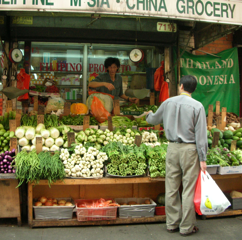Urban Food Systems: Getting Regional Produce on the Shelf
Posted in Exhibitions, Science, The Edible Garden on September 7 2009, by Plant Talk
 |
Valerie Imbruce, Ph.D., Professor and Director of Environmental Studies at Bennington College in Vermont who was a doctoral student at the Botanical Garden, researches the production and distribution of ethnic fruits and vegetables for New York City markets. She will be holding an informal conversation about ethnic fruits and vegetables in Chinatown and urban food systems during Café Scientifique on September 12 as part of The Edible Garden. |
 Cities, home to half of the world’s growing population, are poised to redefine how we produce and supply our food. Cities are where people are demanding more farmers markets and community supported agriculture groups and where there is a local agriculture craze. Food is a social movement with a particularly urban flavor.
Cities, home to half of the world’s growing population, are poised to redefine how we produce and supply our food. Cities are where people are demanding more farmers markets and community supported agriculture groups and where there is a local agriculture craze. Food is a social movement with a particularly urban flavor.
Living in southern Vermont for the past year after being in New York for nearly a decade, I learned that in New York City it is easier to purchase a diet of regionally produced foods than in the food-producing regions themselves because of the structure of our food supply chains.
Since World War II the number of farms in the United States had been declining, but between 2002 and 2007, the last year for which data were available, there was a 4 percent increase. According to the U.S. Census of Agriculture, these new farms are half the size of the average U.S. farm, have younger operators, and have sales of which one product accounts for no more than 50% of the farm income. These are the types of farms, small and diversified run by a new generation of farmers, which farmers markets, community supported agriculture, and chef-farm partnerships have been the primary supporters of.
But direct marketing arrangements are not enough to support a sustained increase in farm numbers: The volume of food sold directly from farm to consumer is a drop in the bucket compared with the volume of food that is sold through wholesale distribution. Why should New York, the second largest apple producing state in the nation, export its apples and then turn around and import apples from Chile and New Zealand for New Yorkers to eat? Why should the United States export more than 4,000 tons of yogurt and then import just over the same volume? It’s because fundamental aspects of the “mainstream” food system make it difficult for regional farmers to access their regional urban markets. We need to get commodity agriculture and supermarkets on board to change this, and we need city government to create policies to ensure access to urban markets by regional farmers.
I would not argue for a solely provincial approach to food distribution—it is either impractical, impossible or both—but I do argue that each bioregion should be encouraged to grow what it is best suited for and that regional farmers should have access to their regional markets. However, that’s not the case right now.
The distribution of food for supermarkets has been centralizing over the past two decades. Fewer food retail companies have more market share while controlling more stages of a food product’s life cycles, from production through retail. This has favored a “get big or get out” mantra in American agriculture and pits U.S. farmers against farmers with lower costs of production in other countries; domestically, it pits farmers from hilly rocky regions like the Northeast against those from the flat, fertile valleys of California and the Midwest.
The farmers markets, community supported agriculture, and the wholesale food system that supply New York’s Chinatown with ethnic produce that I have studied allow farms of many sizes and with fluctuating yields and diverse product inventories to participate, because they all feature a decentralized marketing structure. By decentralized, I mean that many wholesalers and retailers sell farm goods to the Chinatown food system, not just a few. If individual supermarket stores could source their own inventories, instead of being integrated into company marketing channels, then regional farmers would have a better chance of accessing these markets.
Supermarkets in urban areas would have a particular advantage should they want to test out this decentralized distribution strategy. Consumer demand exists and competition is mounting. New York City may be in the vanguard. The city is on the verge of building a wholesale farmers market to provide the infrastructure to connect stores in the city with farmers. Earlier this year, the office of Manhattan Borough President Scott Stringer released “Food in the Public Interest,” a document that recommends re-assessing the city’s food distribution. And Fairway, one of New York City’s premier supermarkets, has started a “Jersey Fresh” display in the produce section to feature tomatoes, zucchini, and other vegetables from New Jersey.
The situation is ripe for change.

